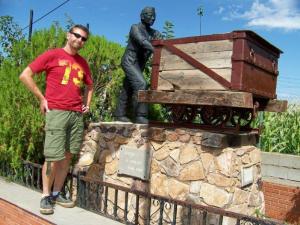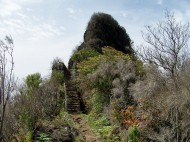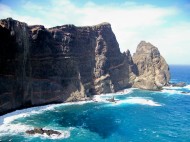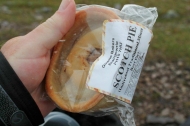 ON the plain beneath the northern slopes of??Spain’s Sierra Nevada mountains lies the redundant iron mining community of Alquife. It???s a quiet, almost jaded sort of place that reminds me of the redundant iron mining community where I grew up ??? one road in and one road out; a scattering of shops; a few pubs; and an abundance of dull red spoil heaps on the outskirts standing as a reminder that something once took place here.
ON the plain beneath the northern slopes of??Spain’s Sierra Nevada mountains lies the redundant iron mining community of Alquife. It???s a quiet, almost jaded sort of place that reminds me of the redundant iron mining community where I grew up ??? one road in and one road out; a scattering of shops; a few pubs; and an abundance of dull red spoil heaps on the outskirts standing as a reminder that something once took place here.
I suppose that in Alquife??there are grandfathers who walk their grandsons along the abandoned railway lines and tell them stories of when things were different and perhaps more prosperous, just as my grandfather took me around the overgrown and decaying industrial remains of Askam-in-Furness??when I was a child. Iron will be in the blood in Alquife. It???ll be under the finger nails and ingrained in the soul. I know this.
Alquife???s backdrop is the hazy Cerro de Piedras??Blancas??and the foothills of the high sierra. Askam???s backdrop comprises fells that stretch west from Coniston Old Man to Crinkle Crags, Scafell Pike and the dark bulk of Black Combe.
Alquife??is a little dustier than the village of my childhood, and its climate is preferable to one that???s battered by gales from the Irish Sea and blizzards from the north. But Alquife??has been, for many years, a place I???ve longed to visit for it shares more than a few coincidences of fate with the distant Askam. It has a historical link.
 From 1899 to well into the 20th??Century, the Alquife??mines were owned and worked by the Millom??and Askam??Heamatite??Iron Company. Millom??is a redundant iron mining and smelting community on the west bank of the Duddon??estuary, in Cumbria. Askam is all those things but on the east bank of the estuary. Millom???s sole claim to fame is that it was the birthplace of the poet Norman Nicholson. Askam???s sole claim to fame has yet to emerge, though it once featured in a Hairy Bikers series (Si and Dave cooked Thai curry, would you believe) and its most southerly signal-box made a fleeting appearance in the 1970 film version of Samuel Youd???s The Death of Grass.
From 1899 to well into the 20th??Century, the Alquife??mines were owned and worked by the Millom??and Askam??Heamatite??Iron Company. Millom??is a redundant iron mining and smelting community on the west bank of the Duddon??estuary, in Cumbria. Askam is all those things but on the east bank of the estuary. Millom???s sole claim to fame is that it was the birthplace of the poet Norman Nicholson. Askam???s sole claim to fame has yet to emerge, though it once featured in a Hairy Bikers series (Si and Dave cooked Thai curry, would you believe) and its most southerly signal-box made a fleeting appearance in the 1970 film version of Samuel Youd???s The Death of Grass.
So with thick cloud hugging the Sierra Nevada and a weather forecast that offers little hope of climbing mountains, I???m having a couple of hours wandering??Alquife???s dusty streets, trying to feel at home and looking for links to Askam and cultural similarities.
According Christopher D Jones, an old mining friend of mine who has visited these parts, the recently demolished??co-operative store still carried its Millom??and Askam??Heamatite Iron Company motif above the door. Alas, ???recently demolished??? means another link sundered. This community produced 40 per cent of the iron mined in Spain, and all that remains is an ore-tub memorial, a couple of plaques ??? and a vast wasteland of mining buildings that???s fenced off behind barbed wire to prevent enthusiastic people like me killing themselves in abandoned workings.
Does Alquife??have a silver band like the mining village of my childhood, I wonder? Do geese chase strangers along the street? Is there a decent chip shop? Where???s the rugby league pitch? What about whippet and pigeon racing? Do men fight with shovels outside the pubs? Alas, these are questions that will never be answered. Not today anyway, because it???s Sunday and everywhere is shut. Bugger. At least Askam Co-op???s open on a Sunday. Even though there???s no company motif above the door.
It???s a long drive back to Orgiva??over the mountain passes. But as the rattly??car descends the winding road towards Laroles the cloud begins to break and the sun shines through. Goodbye dusty plains and long-buried links to the past. Goodbye fellow people of the red earth. Mountain-climbing weather has returned.
- Alquife iron mining links:
Some notes by Rob Vernon, De Re Metallica 2006
Historical notes by the Tourism office of Granada
References to Millom??and Askam??Co files relating to Alquife in Barrow Record Office






























Thanks, that was a very interesting read. I am currently based in southern Spain and am quite keen on finding more out about this once great industry of the region. With its connections to the UK, the Alquife Mining and Railway Company particularly catches my interest. I have been trying to locate its company logo – would you happen to know of a photo of this anywhere?
Again, thanks for the interesting read.
Hi. Thanks for that. I’ll look into the logo thing. Off the top of my head, I don’t think I’ve come across one, but I have a friend who has been out there a few times and has done quite a bit of research. I’ll see what I can come up with. Cheers now.
Great article. I’ve been reading about the Alquife Mines, there are reports that they’re about to re-open and re-start production. I think this would be great for the revival of the old mining community. Any idea if this is true or who currently owns the mines?
Hi Flee. This is news to me. But I’ve heard recently that the fluorite mines on Sierra Lujar have just reopened, so perhaps there’s some sort of revival taking place. I’m going over there soon so if I find out anything I’ll let you know.
Cheers, Alen
Hi Alen. Only just found this thread. There isn’t any movement currently on the re-opening of the mine as the difficulty lies with offloading the iron at Almeria. ‘El Cable Ingles’ is a listed structure and in any case the local council aren’t keen to have everywhere coated in a fine red dust again. Carboneras has been mentioned as a possible shipment port but that would mean construction of a rail link.
In any case the price of steel has dropped, possibly making the mine uneconomic again.
I was last there 18 months ago and the dereliction of the village and mine continues apace.
CDJ
Hi Chris. Good to hear from you. Thanks for the update. Shame about the mine but I can understand the reluctance to have everything coated with dust. Anne and I are looking to move to the Sierra Nevada in the near future, so next time you’re over there you must call in. I shall furnish you with details as and when things become more solid.
Cheers, Alen
Just let me know. I was in Granada last week. I have leads on 100’s of mines in the area everything from silver downwards. Called in to see the Almaden Mines museum on which they’re doing an excellent job. Employing people with special needs which is why I was in the area in the first place. Off to Slovenia in 6 weeks on a similar quest.
I’m glad you’re moving out there, I need a companion to complete El camino del Rey at El Chorro. Bit scary but amazing views. Also a load of mines to explore in the Sierra Almagrera.
Er, yes, I’ve seen the video of El camino del Rey. I’m not so sure I want to have a go at that. I’ll have a crack at some mines though. Still got most of the gear.
I’ll let you know when we get things sorted.
Cheers, Alen
I was at a mining archaeology conference in Granada last week – the Saturday field visit was to the Alquife Mine lead by a member of the Fundicion Minas de Alquife. The Fundicion have actually produced a well illustrated book about the mine, but didn’t have any with them for sale on the day!
I understand that many of the issues / problems associated with the reopening of the Alquife mines are environmental. Since the tailing dam burst at Aznalc??llar mine, Huelva in 1998, resulting in an environmental disaster, the Junta de Andalucia have become very strict about how mines operate.
It was pleasing to see that the scrap metal dealers have not been allowed to plunder the site too much and the plant is still there. It is a pity that the mining settlement has fallen into such decay. I first visited the mine when it was still working in 1983, I seem to recollect that even the cats were red – covered in fine haematite dust!
Hi Rob. Thanks for the update. It???s good to know that the industry isn???t dead, the plant is still in one piece and there are people involved in documenting its history. So much has disappeared from my native Furness since the 1940s it would be very easy to believe that no haematite mining took place.
I think our paths have crossed in the past. I used to represent the Cumbria Amenity Trust Mining History Society at the NAMHO conferences in Matlock back in the 1980s along with David Blundell. But that seems like an age ago now.
I had a chuckle at the red cats. Before the A590 was diverted around Backbarrow in the 1960s it used to snake through the middle of the ???Blueworks???, which produced dolly blue for Reckitt and Sons. The cats were blue.
Cheers, Alen